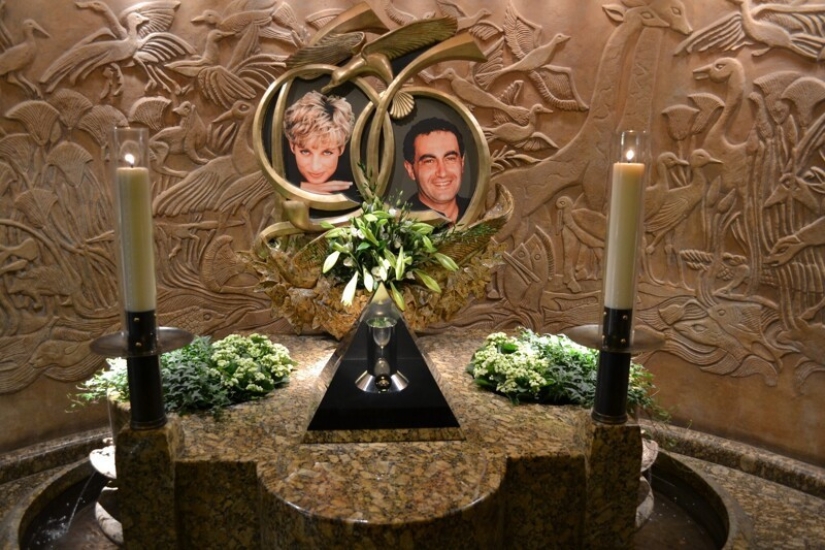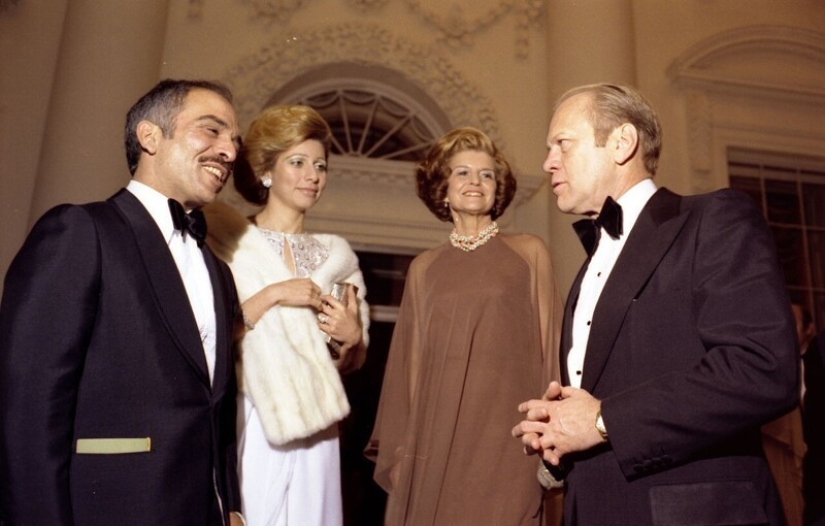20 historical facts about the ill-fated novels and intrigues of kings
Love stories related to royalty always attract the attention of the public – both in the old days and now. Maybe that's why we know so much about unsuccessful and often tragic royal romances. Here are some stories from the category "and then they did not live happily ever after".

Of course, it is worth starting with the English King Henry VIII and his many unsuccessful marriages. He first married Catherine of Aragon. However, their relationship soon soured. Catherine was unable to produce a male heir (although she gave birth to the future Queen of England Mary I).
Henry VIII tried to annul the marriage. The Catholic Church refused him, so he passed a law on the separation of the Anglican Church from the papal authority. Then Henry VIII married Anne Boleyn, who gave birth to another girl (also the future Queen of England, Elizabeth I). But he again did not receive the desired male heir. In the end, Anna was accused of treason and executed (in fact, by this time Henry was already having an affair with Jane Seymour).

Then the restless king married Jane Seymour, who finally gave him the desired male heir in the person of Edward. But Jane tragically died shortly after giving birth. The next marriage of Henry VIII with Anne of Cleves was quickly dissolved without any special incidents. Then he married Catherine Howard, but then discovered that she was unfaithful to him, imprisoned and executed.
Finally, Henry VIII married Catherine Parr, his sixth and last wife. He lived with her until his death in 1547.
If you've watched the Netflix series "The Crown", you're probably familiar with the sad story of Princess Margaret and Air Force Officer Peter Townsend. For the uninitiated: Margaret and Peter have been in love with each other for many years. However, the fact that Peter had previously been married and divorced made a marriage between them impossible.

The same thing happened a little earlier with Margaret's great-uncle, Edward VIII. In both cases, the British government and the Anglican Church opposed the marriage of a member of the royal family with a divorced person whose first spouse is still alive. Margaret could only marry Peter Townsend if she gave up her place in the succession to the throne. And perhaps, even in this case, she would still somehow have been pressured and banned this marriage.
Eventually, the two broke up, unable to withstand several years of separation (Townsend was specifically sent away from Margaret) and constant pressure. Then the princess married the photographer Anthony Armstrong-Jones. And Peter Townsend tied the knot with a young Belgian woman named Marie-Luce Jamagne, who, according to many, is very similar to Margaret.
When Edward VIII became king of England in 1936, he was not married, but was in a romantic relationship with an American Wallis Simpson. She was previously divorced and is still formally married to her second husband. Edward passionately wanted to marry Simpson, but this was categorically denied to him.

After much thought, love won, but for this Edward had to give up the throne. In the end, the couple married – in 1937, in a private ceremony in France. The new king of England, George VI, the younger brother of Edward, banned members of the royal family from attending the wedding.
Edward and Wallis Simpson left England (or were forced to leave) and remained together until Edward's death in 1972.

The marriage of Prince Andrew and Sarah Ferguson began to disintegrate, as Andrew was absent from home for a long time due to his naval service. Ferguson was often seen with other men, and as a result, the couple announced their divorce in 1992. For the royal family, everything connected with Sarah Ferguson carries a tinge of shame – after the British tabloids published photos of her sunbathing topless with some American businessman. The couple officially divorced in 1996.

Prince Charles, the heir to the British throne, married Diana Spencer in 1981, in a lavish ceremony that was watched by 750 million people around the world. However, the supposed fairy-tale marriage of the future king and his queen actually looked more like a horror movie.
The age difference of almost 13 years and the general incompatibility, the ongoing romance of Charles and his long-time girlfriend Camilla, and as a result, infidelities on both sides. The palace announced the couple's divorce in 1992, although the problems between the two began much earlier. They officially divorced only in 1996.

In the summer of 1997, Princess Diana began a relationship with Dodi Al-Fayed, the son of the British Egyptian billionaire Mohamed Al-Fayed. Unfortunately, a car accident claimed the lives of Diana, Dodi and their driver. The couple had just completed a joint vacation in the south of France and was heading to London.

Ali Khan was the son of Aga Khan III, the leader of the Ismaili Muslims, who had a "princely" status received from the British rulers in India. Prince Ali Khan was something of a playboy and dated many famous socialites and movie stars. After his divorce from his first wife, Ali married Hollywood star Rita Hayworth. However, he did not leave his former habits, which the newly-made wife did not like very much – for example, she was very angry when he danced with the Hollywood actress Joan Fontaine... The couple also had disputes about what religion to raise their daughter Yasmin in. In general, everything ended in divorce in 1953-just four years after the wedding.

In the early 1980s, Prince Andrew began a relationship with the American actress Koo Stark. The two were obviously in love with each other, and Andrew was going to propose. However, the press, and then the royal family soon learned that Stark had starred in a rather racy film called "Emily". Due to pressure from the family, Andrew had to end this relationship.

Princess Anne and Mark Phillips first met at a party for horse lovers in 1968. Five years later, they officially tied the knot. The couple had two children, a son Peter and a daughter Zara. However, as in the case of the marriage of Anna's brothers Charles and Andrew, the marriage of Anna and Mark was marked by infidelity and ended in divorce.
In particular, Mark became the father of a child from Anna's extramarital affair with a school teacher from New Zealand.
Caroline Matilda was born a princess of Great Britain, and later became Queen Consort of Denmark and Norway when she married King Christian VII. There was, however, no passion between them. King Christian VIII was in no hurry to consummate his marriage and treated his wife coolly throughout their relationship. He also had a number of extramarital affairs.

He also suffered from a mental illness. As a result, his doctor Johann Friedrich Struensee became the de facto regent. Struensee and Caroline Matilda had to rule together – and in the process they became closer and fell in love with each other. It is widely believed that it was Struensee who was the father of Caroline Matilda's second child.
In the end, someone "caught" Struensee and Caroline Matilda. Her relatives sent her to Hanover. This meant that they separated her from the children and she never saw them again. Struensee suffered an even more tragic fate – he was executed.
Cleopatra was the ruler of the Egyptian kingdom of the Ptolemaic period. She formed a strategic alliance with the triumvirate of Octavian, Lepidus and Mark Antony in their battle against the conspirators who took the life of Julius Caesar. In the process of this union, Cleopatra and Mark Antony began one of the most legendary novels in history.

After a while, Mark Antony quarreled with Octavian, who already had a grudge against him – after all, Antony had previously been married to his sister, and then left her because of Cleopatra. Finding a suitable reason, Octavian declared war on Antony and Cleopatra. Before Octavian's imminent invasion of Egypt, Mark Antony stabbed himself with a sword and was taken to Cleopatra, where he died in her arms. Soon after, Cleopatra committed suicide. And Octavian annexed Egypt to the Roman possessions.
Like most of the rulers of the Mughal Empire, Shah Jahan had several wives. But his favorite wife was Mumtaz, whom he called his main empress. Throughout their marriage, she served as a valuable confidant and accompanied her husband even during military campaigns.

After Mumtaz died giving birth to her 14th child, Shah Jahan decided to honor her memory in a truly grandiose way. He ordered a huge mausoleum made of marble, which was supposed to be the last refuge of his beloved. This mausoleum was the Taj Mahal, one of the best examples of Mughal architecture and one of the most recognizable structures in the world.
Pedro was the heir to the Portuguese throne. Although he was married to Constance, he quickly became infatuated with one of her ladies-in-waiting, Inez de Castro, and began an affair with her. When Constance died, Pedro asked his father, King Afonso IV, for permission to marry Ines. However, Afonso refused, fearing that her connections with the Castilian nobility could undermine their power. Instead, Afonso excommunicated Ines from the royal court.

The couple still secretly maintained a relationship and managed to give birth to three children during this time. When Afonso found out about this, his reaction was frightening: he ordered the execution of Ines (the extra heirs were inappropriate, this could lead to a fratricidal war in the future).
After the death of his father, Pedro became king of Portugal, and one of his notable achievements was that he found the murderers of Ines and brought them to justice. Although one of them managed to escape, he sentenced the other two to death. According to legend, he tore the hearts of the murderers out of his chest as payback for what they did to him.

Queen Victoria of England and her husband Prince Albert were married in 1840. During the 21 years of their marriage, the couple had nine children. Unfortunately, Albert died in 1861 at the relatively young age of 47 from typhoid fever. It was a terrible loss that Victoria could not overcome. For the rest of her life, she wore mourning for her husband and tried to participate in public life as little as possible.

As you know, Queen Elizabeth I of England was never married, and historians call her the Virgin Queen. The only person Elizabeth wanted to marry was Robert Dudley, her childhood friend and confidant. When Dudley's wife Amy passed away, Elizabeth and Dudley seriously considered getting married. However, many speculated that Amy's death could have been a murder committed by Dudley. As a result, influential advisers dissuaded Elizabeth from this marriage.
After his first two marriages ended in divorce, King Hussein of Jordan married for the third time to Alia Baha ud-din Toukan. Queen Alia and King Hussein gave birth to two children and adopted a third child from a refugee camp. King Hussein helped create the Office of the Queen of Jordan, which allowed Queen Alia to engage in various social development projects close to her heart.

She played an important role in giving Jordanian women the right to vote. Unfortunately, their marriage and Aliya's life were interrupted when she died in a helicopter crash in 1977. The Queen was only 28 years old.
In 1796, Napoleon Bonaparte married Josephine Beauharnais. Although they both had extramarital affairs, in fact, they loved each other immensely. Unfortunately, the Empress Josephine was unable to produce an heir. As a result, they agreed to a divorce so that Napoleon could remarry and give birth to the desired heir.

Even after the breakup of their marriage, Napoleon still had feelings for Josephine. He was in exile on the island of Elba when he heard of her passing and was reportedly so depressed that he locked himself in his room for two days. When Napoleon died on the island of St. Helena in 1821, his last words were: "France, the army, the head of the army, Josephine."
Maria Antonia was born as Archduchess of Austria. Her mother, Empress Maria Theresa, decided to end hostilities with France by arranging a marriage with her then 14-year-old daughter and heir to the French throne, Louis-Auguste. Four years after the wedding, Louis-Auguste ascended the throne as Louis XVI, and Marie Therese, now known as Marie Antoinette, became Queen of France.

However, their rule was marked by scandals that further fueled the French public's disillusionment with the monarchy. Marie-Antoinette was accused by many in France of excessive extravagance, exacerbating the country's financial problems. In 1789, the French Revolution broke out, the main goal of which was the abolition of the monarchy. The revolutionaries declared France a republic in 1792. The following year, they executed Louis XVI and Marie Antoinette on the guillotine.
Although both Mary of Edinburgh and Prince George of Wales were both grandsons of Queen Victoria, which made them a cousin and a cousin, they had a romantic relationship. George was fascinated by Maria's" sparkling blue eyes and silky blonde hair". He wanted to make her a marriage proposal, and the couple even received the approval of George's grandmother, Queen Victoria, and their fathers.

However, both their mothers were against this union. George's mother did not like the pro-German sentiments of Maria's family, and Maria's mother, who grew up in the Russian Orthodox Church, was against marriages between cousins. As a result, George became King George V of England, and Maria became the wife of the King of Serbs, Croats and Slovenes, later the King of Yugoslavia.
In 1900, King Alexander I of Serbia announced his intention to marry Draga Mashin, a former maid of honor of his mother, who at the age of 36 was 12 years older than him and had already been married before. The huge age difference, the low probability that she would have an heir, and the fact that she had a low status meant that the union met numerous objections from both Alexander's family and the Serbian people.

Alexander, however, insisted on his own, and caused even more outrage by calling Draghi's brother the presumptive heir to the throne. As a result, a group of conspirators from the Black Hand organization planned and carried out a coup, storming the royal palace and seizing power. The king and queen were brutally murdered, their corpses were mutilated and thrown out of the window into the palace garden, where they lay for several more days.
Keywords: History | World | Past | King | Queen | Royal family | Romance | Kingdom | Stories | Lovers
Post News ArticleRecent articles

In the fall of 1972, Bill Yates traveled through the countryside in the vicinity of Tampa, Florida. At that time, he was studying ...

Severe cold weather does not give up its positions. We offer you to admire the magical photos of winter Europe, because snow and ...
Related articles

In the fall of 1972, Bill Yates traveled through the countryside in the vicinity of Tampa, Florida. At that time, he was studying ...

When a person is in a life-threatening situation is awful, but even worse when it happens to a child. 11-year-old American Terry ...

Remember how broke the "unbreakable" scoop? The photo preserved in the photo album of almost every family! A selection of vintage ...

Vladimir Lyubarov is an artist from the countryside who paints pictures of real life. But he brings amazing characters, birds, and ...